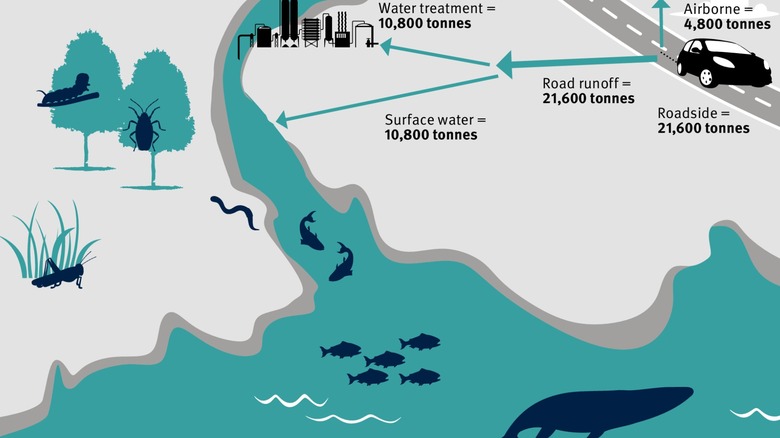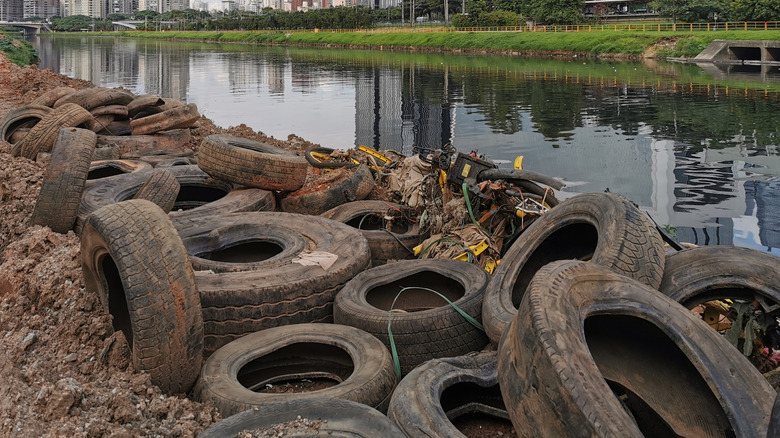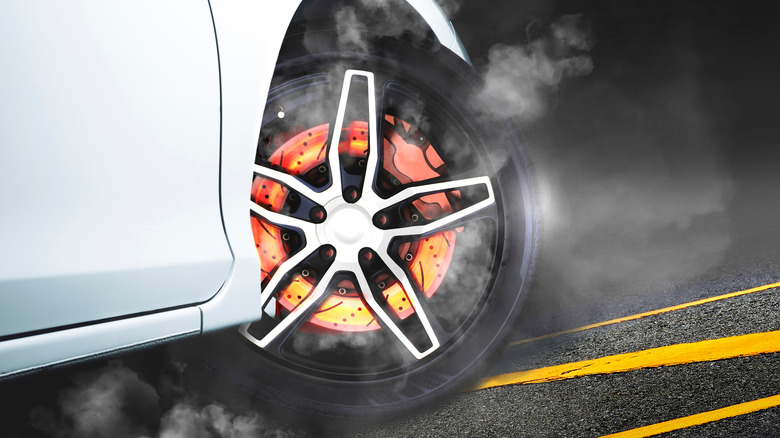Here's How Your Car Tires May Be Slowly Harming You (And Everybody Else)
Every discussion about automobiles' environmental impact focuses on their direct energy roots. For combustion-based machines, it's always the fossil remnant injecting harmful gases into the atmosphere. When it comes to electric cars, it's the batteries that raise concern. But one crucial aspect that has flown under the radar is the environmental burden of tires. More specifically, the tiny particles ejected from the surface over the natural course of wear and tear.
According to research (PDF) from the Imperial College London, six million tonnes of tire wear waste are produced worldwide annually. These particles can range in size from micrometers to nanometers and are observed in various forms depending on the wear mechanism. Researchers have discovered that numerous nano-sized particles, called 'ultrafine particles, are released in large amounts from tires. This is concerning because these particles are tiny enough to interact with our cells and might be harmful, especially since they contain toxic chemicals as their constituents used at the manufacturing stage.
In that batch of discarded ultrafine materials, the concentration of PM2.5 and PM0.1 particles is the highest. If that number rings some bells, that's because PM2.5 is advertised as the industry-wide metric for outdoor and indoor pollution. Based on previous research, constituents of automobile tires pose various kinds of health risks ranging from digestive and eye disorders to severe respiratory problems and organ failure. At the same time, they are seriously degrading marine biology at discarding hubs.
How are tire particles affecting humans?
As mentioned above, tire particles come in various shapes and sizes. Some are directly analogous to the size of cells in our bodies, while others are significantly smaller. The smaller ones, however, are known to exhibit a process called agglomeration that essentially brings together clusters of these particles and turns them into a more significant mass. Notably, studies suggest that we might be greatly underestimating how many ultrafine particles there are and in what ways they are affecting different body systems.
The negative effects of these particles mostly have to do with the materials that go into the tire manufacturing process, which includes heavy metals like Lead and Zinc, as well as complex chemicals such as benzothiazoles, isoprene, and polyaromatic hydrocarbons (PAHs), among others. Primarily existing as particulate matter in the air around us, human exposure to PAHs may occur from inhalation, dermal exposure, or ingesting contaminated food. According to the World Health Organization and research published in the Chemosphere journal, PAHs are linked to a rise in cancer cases, including breast cancer, childhood cancer, and lung cancer.
They also affect lung function, worsen asthma, lead to more cardiovascular diseases, and interfere with children's cognitive development. The Agency for Toxic Substances and Disease Registry of the U.S. government states that PAHs usually have minimal immediate toxicity to humans. Yet, long-term exposure can impact the respiratory, digestive, urinary, and skin systems. Regarding cancer, the most affected areas are the skin, lungs, bladder, liver, and stomach.
The risks are multi-fold
TWP, or tire wear particles, are tiny particles that come off tires when driving, caused by the friction between the tires and the road. However, the kind of health hazards they pose depends on their make or the chemicals involved in their production. Lead and zinc happen to be the most worrisome metallic constituents. According to the World Health Organization, ingestion of lead-contaminated food, water, and dust is a key route of human exposure.
As far as the health impact goes, the Centers for Disease Control and Prevention (CDC) and the United States Environmental Protection Agency (EPA) note that Lead exposure is particularly worrying for children as it can cause damage to their nervous system and brain, slow down the pace of development, hinder the learning capabilities, and lead to speech and hearing problems. In adults, it can trigger issues related to blood pressure, reproductive health, memory woes, and muscle and bone-related issues.
"Tire debris contains significant quantities of zinc," says the Agency for Toxic Substances and Disease Registry, further adding that road dust from tire abrasion was the main reason zinc concentration is higher near expressways. Research says Zinc toxicity can result in anemia, jaundice, trigger pathological damage to the kidneys, gut corrosion, and irritation, among others. Also found in TWP are Benzothiazoles and Isoprene, which are carcinogenic and mutagenic and can lead to severe issues affecting the reproductive as well as respiratory problems.
The impact on ecology
Worryingly, scientists are worried about not just direct airborne ingestion. Tire wear particles and their components might build up in the food chain, following paths similar to microplastics. Given the current trajectory, that's not entirely implausible. According to research published in the Science of The Total Environment journal, tire particles play a major role in the overall microplastic emissions, comprising anywhere between 50 to 80% of emissions in countries such as China, Denmark, and Sweden.
When dumped in aquatic bodies, it can inhibit algae growth, lead to metal toxicity, and, under certain conditions, affect fish living in those bodies. In extreme cases, it can turn the entire water stream toxic, as detailed in this Science research paper, in which mass death of salmon is reported. "The risk is greatest adjacent to storm drain outfalls where particles and leachates may be more concentrated in shoreline surface water following rainfall events," says another research paper.
The EPA has acknowledged the challenges in managing tire wear particles on roadways and waterways. Unfortunately, not much research has been done in the field, which significantly hampers the availability of knowledge and the search for appropriate mitigation strategies. Scientists are therefore calling for measures such as a better understanding of tire particle emissions, changing their composition, mapping their airborne and aquatic spread, and how they impact humans and animals that become a part of the food chain, directly or indirectly.
The solutions at hand
The EPA is exploring opportunities to enhance awareness and management of this environmental concern. To better address this issue, the agency seeks relevant information, data, and tools to aid in effective management. Additionally, it is considering initiating specific roles or products to tackle the issue of tire wear particles more efficiently. But the situation is not a straightforward endeavor. The type and amount of particles produced varies based on factors such as the composition of the tire, the speed and style of driving, the type and condition of the road surface, temperature, and other environmental elements.
Research published in the Polymers journal says modifying tire treads could help here. However, the variable composition of tires makes it difficult to generalize their net impact. The EPA suggests monitoring environmental particles in the air and surface water runoff, which is key to understanding and addressing the issue. The agency emphasizes a standardized approach to collecting, separating, and quantifying these particles or validating existing methods to enhance future research.
Furthermore, it's considering mitigation strategies like reformulating products, implementing voluntary tire ingredient review systems, establishing and adopting standards for reduced tire abrasion rates, and modifying road surfaces to lessen tire wear. The EPA is even exploring ways to decrease vehicle miles traveled and alter driver behaviors to reduce tire wear. With an eye on future developments, the EPA notes that self-driving cars could be programmed to minimize tire wear through optimized braking techniques.




